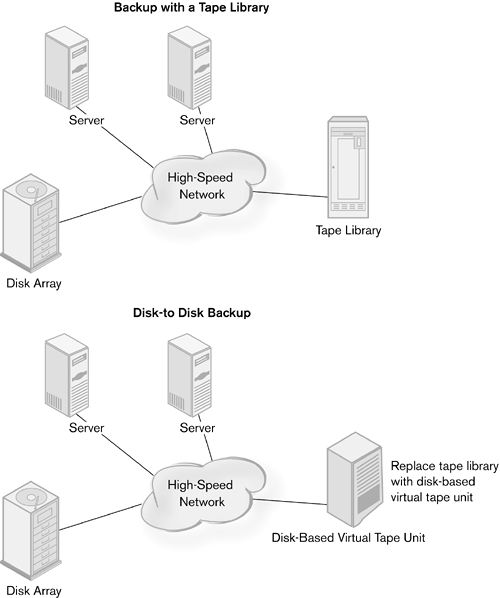Disk-to-Disk Backup
| < Day Day Up > |
| Although tape is inexpensive and reliable, it suffers from several deficiencies that have become less acceptable to IT management. Tapes wear out and can degrade much more quickly than other media. Tapes are relatively slow, causing problems with backup windows. Just-in-time or continuous backups are nearly impossible with tape. These issues pale in comparison with the problem that tape presents for restore. When disaster does happen, and important data has been destroyed from primary storage, it is always desirable that the data be restored as quickly as possible. Tape systems are often too slow to accommodate required service levels. Take the case of a 1-terabyte array backed up to a SDLT 600 with 2:1 compression. Backing up that much data would take two full tapes, each holding 600 gigabytes of data. Further assume that these tapes are in a library with a fast interface and have hardware assist for the data decompression. This allows the full throughput of 72 megabytes per second, with only a minute or so to change tapes. At this rate, it will take nearly four hours to restore the array completely. This is a highly optimistic analysis. It presumes using one of the fastest tape drives available, no loss of throughput due to decompressing the data (which is not realistic), and nothing going wrong. To restore a terabyte array in the real world is going to take much longer, perhaps twice that time. Disk drives, on the other hand, have much faster throughput. A typical disk array is capable of keeping a 200-megabytes-per-second Fibre Channel connection completely full. Restoring a 1-terabyte array at that rate would take only 83 minutes. Even if this is an optimal calculation, it can still be assumed that restoring the array would happen in about 90 minutes a huge difference when recovering critical data. To address problems with restore, a new approach to backup and restore was devised, using disk arrays instead of tape libraries (Figure 3-5). Some vendors focused on entirely new ways of backing up data, but the data storage industry has settled on a method called virtual tape. Figure 3-5. Converting to disk-based virtual tape
Virtual tape allows a disk array to emulate a tape system. It does not require rewriting the backup software, reconfiguring systems, or revising backup and restore procedures. From the point of view of the backup software, the disk array is a very fast tape drive. The controllers in the array translate commands intended for a tape drive into those used by the disk system. Nothing else in the system has to change except the backup unit itself, which is designed as a drop-in replacement for the tape drive. Disk-based backup has several other benefits. It is much easier to find data on a disk drive than on a tape. On analog tape systems, finding data on the tape requires that the tape first be rewound to the beginning. It is then slowly searched until the data is found. This is not the case with modern digital tape, but the tape still has to move slowly (by disk standards) to get to the point where the requested data is. If the requested data is at the end of the tape, it might take a while to get to where it is. Not so with disk systems. Random data can be found quickly (the forte of disk systems), making selective recovery of data a more reasonable operation. The speed difference is also an advantage for system administrators who need to shrink their backup windows. Because it is faster to write to disks than to tape, it is possible to back up information much more quickly. This allows the backup window to shrink to nearly zero, enabling near-continuous backup. Point-in-time backup, or making backups at different points throughout the day rather than once a day, makes more sense when the system can perform the backup in seconds or minutes. Because of the large capacities of disk subsystems, many backups can be kept constantly available. It is feasible to perform a full backup each day, with incremental backups throughout the day something that is very difficult to do with tape systems.
Disk-based systems suffer from the same network limitations that tape system do. On a slow network, the interface is the bottleneck, not the media. Performing network backup across a 100BaseT TCP/IP network will not keep a high-end tape streaming at full speed. Moving to disk-based backup will have no positive effect at all. Disk-to-disk backup systems tend to be deployed in Fibre Channel SANs, Ultra3 or better SCSI, and Gigabit Ethernet environments, which can take advantage of the speed of the disk systems. Because there are many benefits to disk-to-disk backup for large installations, why has it taken so long for viable disk-based backup systems to become available? The short answer is cost. For disk backup to make sense, there can be only a small premium over tried-and-true tape systems. Fibre Channel and high-end SCSI drives are too expensive to build cost-effective backup systems. The performance and high reliability that FC and SCSI drives offer are more than backup applications need and cost more than they could bear. Enter ATA and Serial ATA drives. Long thought to be too unreliable or slow for enterprise applications, these drives were found only on desktop machines. When they were placed inside high availability enclosures with high-speed RAID controllers fronting them, however, a balance among performance, reliability, and cost was achieved. This has allowed the technology to proliferate and become another tool for system administrators. |
| < Day Day Up > |
EAN: 2147483647
Pages: 122
